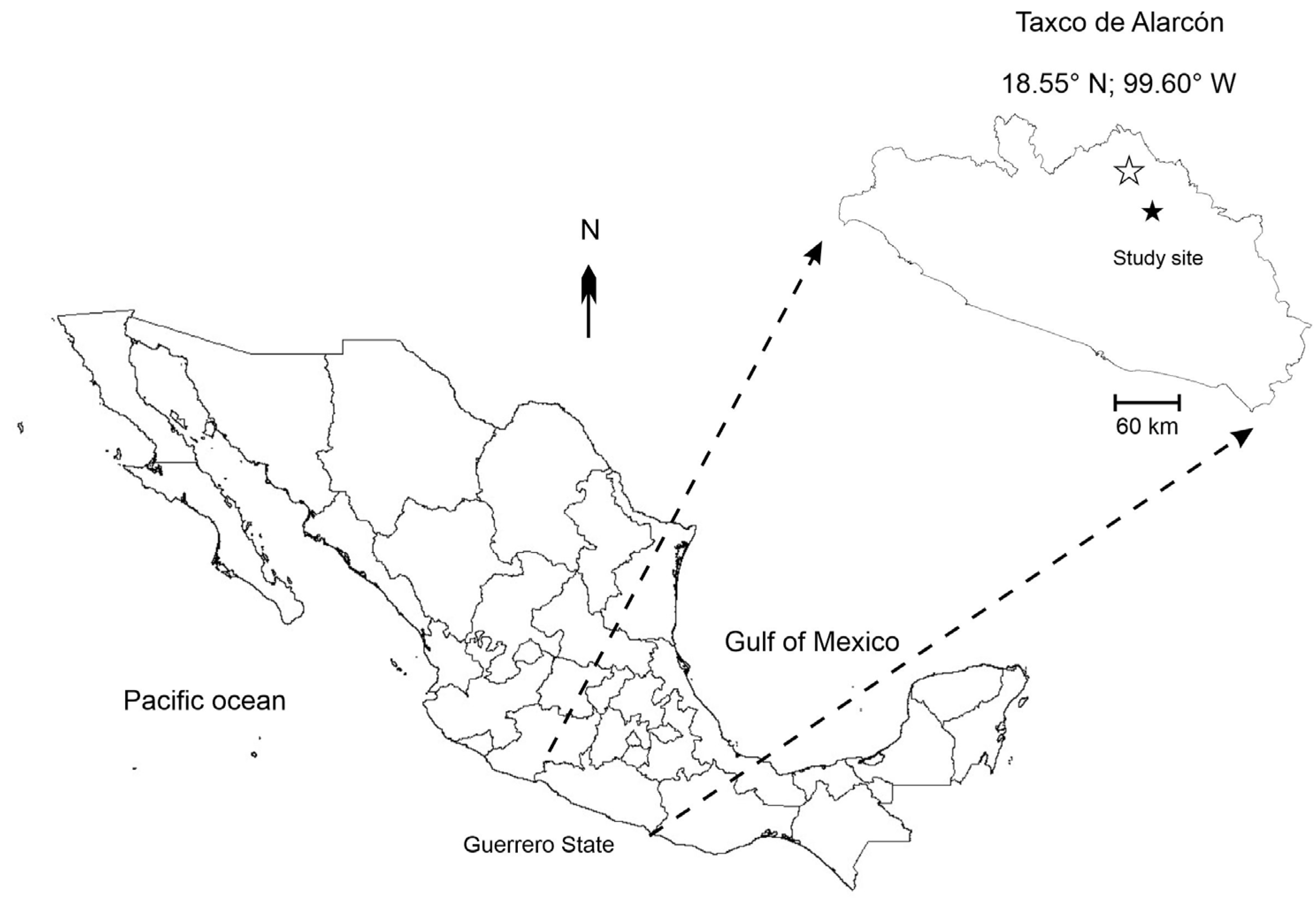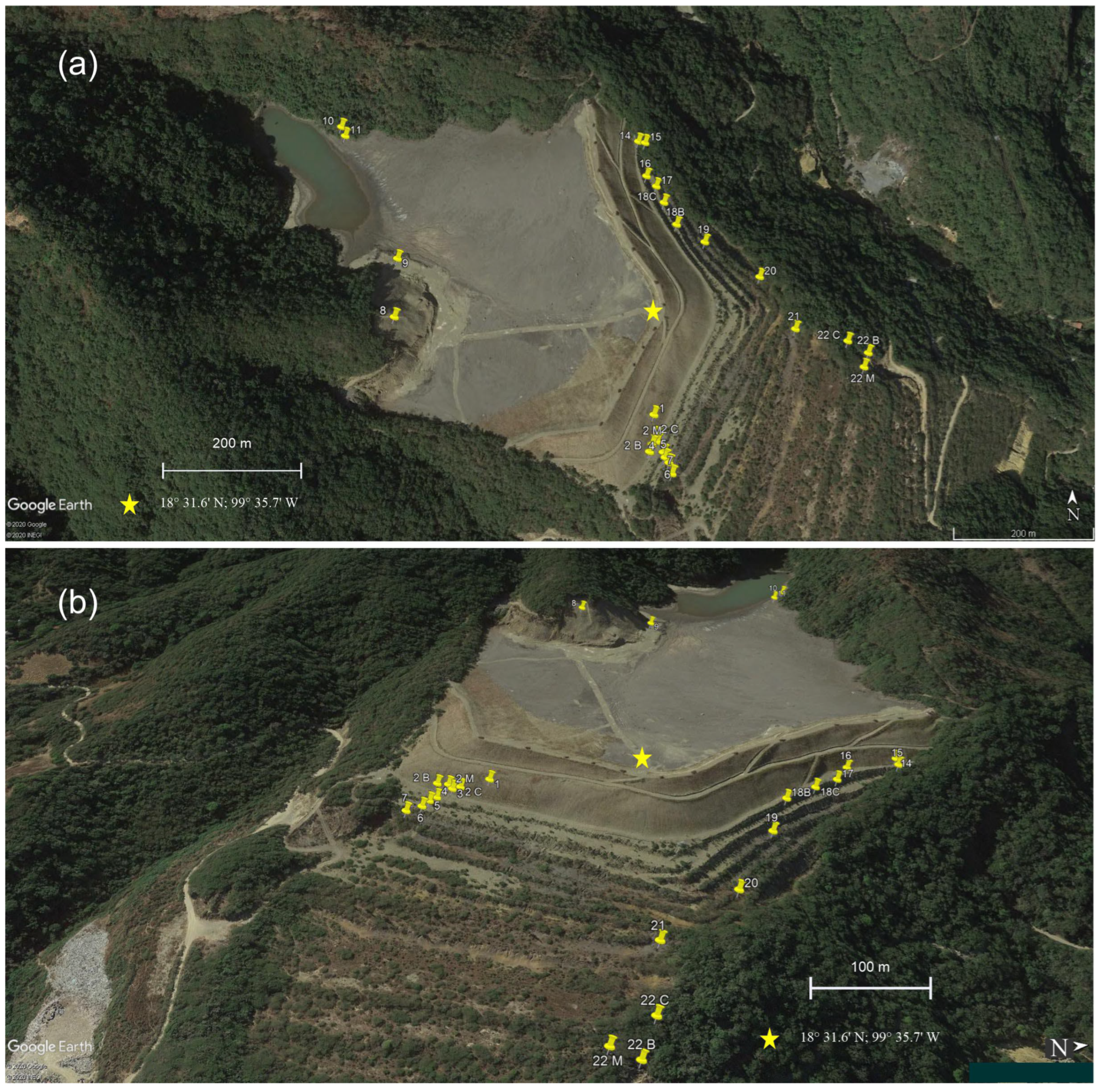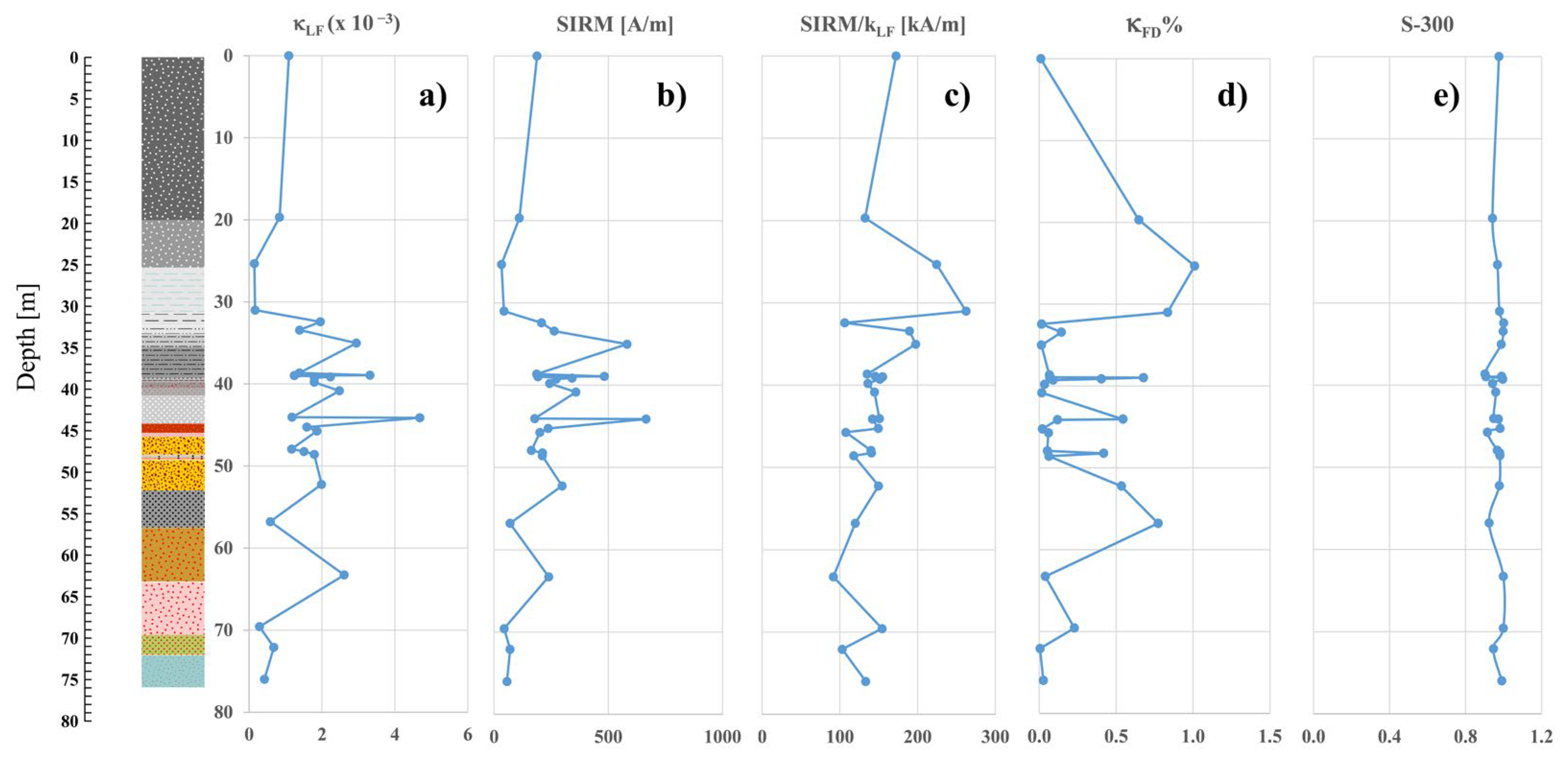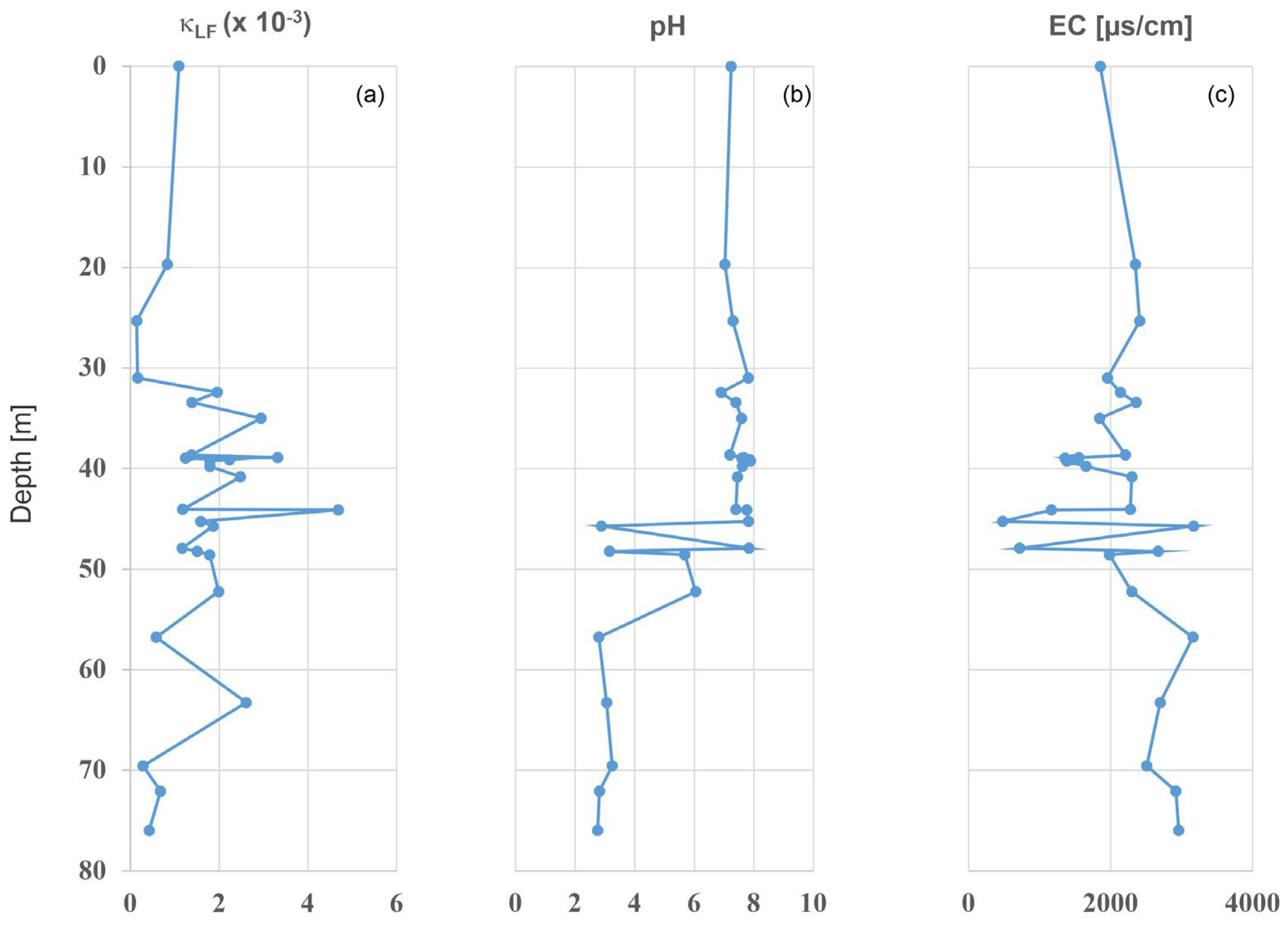Magnetic Susceptibility Prospecting and Geochemical Characterization of Taxco’s Mining Waste Dam Guerrero I (Mexico)
Abstract
1. Introduction
2. Study Area and Historical Background
3. Materials and Methods
4. Results
4.1. Physical and Magnetic Results
4.2. Physicochemical Results
4.3. Geochemistry Results
5. Discussion
6. Conclusions
Author Contributions
Funding
Data Availability Statement
Acknowledgments
Conflicts of Interest
References
- Corona Chávez, P.; Uribe Salas, J.A.; Razo Pérez, N.; Martínez Medina, M.; Maldonado Villanueva, R.; Ramos Arroyo, Y.R.; Robles Camacho, J. The impact of mining in the regional ecosystem: The Mining District of El Oro and Tlalpujahua, Mexico. De Re Met. 2010, 15, 21–34. [Google Scholar]
- Talavera-Mendoza, O.; Yta, M.; Moreno, R.; Dótor, A.; Flores, N.; Duarte, C. Mineralogy and geochemistry of sulfide-bearing tailings from silver mines in the Taxco, Mexico area to evaluate their potential environmental impact. Geofísica Int. 2005, 44, 49–64. [Google Scholar] [CrossRef]
- Dótor-Almazán, A.; Armienta-Hernández, M.A.; Oscar Talavera-Mendoza, O.; Ruiz, J. Geochemical behavior of Cu and sulfur isotopes in the tropical mining region of Taxco, Guerrero (southern Mexico). Chem. Geol. 2017, 471, 1–12. [Google Scholar] [CrossRef]
- International Institute for Environment and Development (IIED). Mining for the Future: Appendix C Abandoned Mines Working Paper; Mining Minerals Sustain Development: London, UK, 2002; Volume 28, pp. 1–20. [Google Scholar]
- Boussen, S.; Soubrand, M.; Bril, H.; Ouerfelli, K.; Abdeljaouad, S. Transfer of lead, zinc and cadmium from mine tailings to wheat (Triticum aestivum) in carbonated Mediterranean (Northern Tunisia) soils. Geoderma 2013, 192, 227–236. [Google Scholar] [CrossRef]
- Castillo, S.; de la Rosa, J.D.; de la Campa, A.M.S.; González-Castanedo, Y.; Fernández-Caliani, J.C.; Gonzalez, I.; Romero, A. Contribution of mine wastes to atmospheric metal deposition in the surrounding area of an abandoned heavily polluted mining district (Rio Tinto mines, Spain). Sci. Total. Environ. 2013, 449, 363–372. [Google Scholar] [CrossRef]
- Cross, A.T.; Stevens, J.C.; Dixon, K. One giant leap for mankind: Can ecopoiesis avert mine tailings disasters? Plant Soil 2017, 421, 1–5. [Google Scholar] [CrossRef]
- Armienta, M.A.; Beltrán, M.; Martínez, S.; Labastida, I. Heavy metal assimilation in maize (Zea mays L.) plants growing near mine tailings. Environ. Geochem. Health 2019, 42, 2361–2375. [Google Scholar] [CrossRef]
- Duan, Z.; Luo, Y.; Wu, Y.; Wang, J.; Cai, X.; Wen, J.; Xu, J. Heavy metals accumulation and risk assessment in a soil-maize (Zea mays L.) system around a zinc-smelting area in southwest China. Environ. Geochem. Health 2021, 43, 4875–4889. [Google Scholar] [CrossRef]
- Bautista, F.; Gonsebatt, M.E.; Cejudo, R.; Goguitchaichvili, A.; Delgado, M.C.; Morales, J.J. Evidence of small ferrimagnetic concentrations in mice (Mus musculus) livers and kidneys exposed to the urban dust: A reconnaissance study. Geofísica Int. 2018, 57, 79–86. [Google Scholar] [CrossRef]
- Armienta, M.A.; Talavera, O.; Morton OBarrera, M. Geochemistry of Metals from Mine Tailings in Taxco, Mexico. Bull. Environ. Contam. Toxicol. 2003, 71, 387–393. [Google Scholar] [CrossRef]
- Ramos-Arroyo, Y.R.; Prol-Ledesma, R.M.; Siebe-Grabach, C. Características geológicas y mineralógicas e historia de extracción del Distrito de Guanajuato, México. Posibles escenarios geoquímicos para los residuos mineros. Rev. Mex. Cienc. Geol. 2004, 21, 268–284. [Google Scholar]
- Talavera-Mendoza, O.; Armienta, M.; García, J.; Flores, N. Geochemistry of leachates from the El Fraile I sulfide tailings piles in Taxco, Guerrero, southern Mexico. Environ. Geochem. Health 2006, 28, 243–255. [Google Scholar] [CrossRef] [PubMed]
- Méndez, M.; Armienta, M. Distribución de Fe, Zn, Pb, Cu, Cd y as originada por residuos mineros y aguas residuales en un transecto del Río Taxco en Guerrero, México. Rev. Mex. Cienc. Geol. 2012, 29, 450–462. [Google Scholar]
- Petrovsky, E.; Kapička, A.; Zapletal, K.; Šebestova, E.; Spanilá, T.; Dekkers, M.; Rochette, P. Correlation between magnetic parameters and chemical composition of lake sediments from northern Bohemia—Preliminary study. Phys. Chem. Earth 1998, 23, 1123–1126. [Google Scholar] [CrossRef]
- Petrovsky, E.; Kapicka, A.; Jordanova, N.; Boruvka, L. Magnetic properties of alluvial soils contaminated with lead, zinc and cadmium. J. Appl. Geophys. 2001, 48, 127–136. [Google Scholar] [CrossRef]
- Ďurža, O. Heavy metals contamination and magnetic susceptibility in soils around metallurgical plant. Phys. Chem. Earth 1999, 24, 541–543. [Google Scholar] [CrossRef]
- Shu, J.; Dearing, J.A.; Morse, A.P.; Yu, L.Z.; Yuan, N. Determining the sources of atmospheric particles in Shanghai, China, from magnetic and geochemical properties. Atmos Environ. 2001, 35, 2615–2625. [Google Scholar] [CrossRef]
- Aguilera, A.; Morales, J.J.; Goguitchaichvili, A.; García-Oliva, F.; Armendariz-Arnez, C.; Quintana, P.; Bautista, F. Spatial distribution of magnetic material in urban road dust classified by land use and type of road in San Luis Potosí, Mexico. Air Qual. Atmos. Health 2020, 13, 951–963. [Google Scholar] [CrossRef]
- Matasova, G.G.; Kazansky, A.Y.; Bortnikova, S.B.; Airijant, A.A. The use of magnetic methods in an environmental study of áreas polluted with non-magnetic wastes of the mining industry (Salair region, Western Siberia, Russia). Geochem. Explor. Env. Anal. 2005, 5, 75–89. [Google Scholar] [CrossRef]
- Pérez, I.; Romero, F.M.; Zamora, O.; Gutiérrez-Ruiz, M.E. Magnetic susceptibility and electrical conductivity as a proxy for evaluating soil contaminated with arsenic, cadmium and lead in a metallurgical area in the San Luis Potosi State, Mexico. Environ. Earth Sci. 2014, 72, 1521–1531. [Google Scholar] [CrossRef]
- Morales, J.; Hernández-Bernal, M.D.S.; Corona-Chávez, P.; Gogichaishvili, A.; Bautista, F. Further evidence for magnetic susceptibility as a proxy for the evaluation of heavy metals in mining wastes: Case study of Tlalpujahua and El Oro Mining Districts. Environ. Earth Sci. 2016, 75, 309. [Google Scholar] [CrossRef]
- Hernández-Bernal, M.D.S.; Morales, J.; Corona-Chávez, P.; Goguitchaichvili, A.; Bautista, F. Combined rock-magnetic and geochemical characterization of Angangueo mining district, central Mexico. Environ. Earth Sci. 2016, 75, 1287. [Google Scholar] [CrossRef]
- IMSA. Geology and Ore Deposits of the Taxco Mining District; Interim Report; IMSA: Guerrero, México, 1978; 40p. [Google Scholar]
- Dearing, J.A. Using the BartingtonMS2 System; Environmental Magnetic Susceptibility; Bartington Instruments Ltd.: Witney, UK, 1999. [Google Scholar]
- Thompson, R.; Stober, J.C.; Turner, G.M.; Oldfield, F.; Bloemendal, J.; Dearing, J.A.; Rummery, T.A. Environmental Applications of Magnetic Measurements. Science 1980, 207, 481–486. [Google Scholar] [CrossRef] [PubMed]
- SEMARNAT. NOM-147, Norma Oficial Mexicana que Establece los Criterios para Determinar las Concentraciones de Remediación de Suelos Contaminados por Arsénico, Bario, Berilio, Cadmio, Cromo Hexavalente, Mercurio, Níquel, Plata, Plomo, Selenio, Talio y/o Vanadio; Diario Oficial de la Federación, 2 de marzo de 2007; SEMARNAT: Ensenada, Mexico, 2007. [Google Scholar]






| Depth [m] | Sample | Color | Size | Consolidation State | Mineralogy | Structure |
|---|---|---|---|---|---|---|
| 0.0 | Gro 8-I | dark gray | fine sands | consolidated | Py + Qz + Mt | well-defined strata |
| 19.7 | Gro 10-II | dark gray | fine size sands | slight consolidated | Py + Qz + Mt | well-defined strata |
| 25.3 | Gro 11-II | light gray | clays | well consolidated | Not observed | fine lamellae |
| 31.0 | Gro 9-I | light gray | clays | well consolidated | Not observed | fine lamellae and desiccation cracks |
| 32.4 | Gro 13-II | dark gray | fine sands (with few clays) | slight consolidated | Qz + Mt + Py + Lithics (Mexcala Fm.) | |
| 33.4 | Gro 12-II | light gray | fine sands–clays | consolidated | Qz + Py + Lithics (Mexcala Fm.) | fine lamellae |
| 35.0 | Gro 1-I | dark gray | fine sands–clays | partially consolidated (summit of the dam) | Qz + Mt | |
| 38.7 | Gro 14-II | dark gray | fine sands (with few clays) | consolidated | Qz + Mt + Py + Ca + Lithics (Mexcala Fm.) | fine strata and lamellae |
| 38.9 | Gro 2-I C | dark gray | medium size sands–clays | partially consolidated | Qz + Mt + Py | |
| 39.0 | Gro 15-II | gray reddish | fine size sands | consolidated only superficially (3 cm) | Qz + Mt + Py + Lithics (Mexcala Fm.) | |
| 39.1 | Gro 2-I M | dark gray | medium size sands–clays | partially consolidated | Qz + Mt + Py | |
| 39.3 | Gro 2-I B | dark gray | medium size sands–clays | partially consolidated | Qz + Mt + Py | |
| 39.8 | Gro 3-I | dark gray with some reddish areas (oxidation) | medium to fine size sands | partially consolidated | Qz + Mt + Py | |
| 40.8 | Gro 16-II | gray | fine size sands | consolidated only superficially (3 cm) | Qz + Mt + Py + Ca + Lithics (Mexcala Fm.) | |
| 44.1 | Gro 17-II | gray | fine size sands | consolidated only superficially (3 cm) | Qz + Mt + Py + Lithics (Mexcala Fm.) + Gy? | |
| 44.1 | Gro 4-I | reddish | medium size sands–clays | partially consolidated | Qz + Mt + Py + Ca + Gy? | |
| 45.3 | Gro 5-I | reddish | fine sands–clays | partially consolidated | Qz + Mt + Py + Gy? | |
| 45.7 | Gro 18-II C | ochre | medium to fine size sands | well consolidated | Qz + Mt + Py + Gy? | |
| 47.9 | Gro 6-I | light gray | medium to fine size sands | consolidated | Qz + Mt + Py + Ca | fine strata and lamellae |
| 48.2 | Gro 18-II B | ochre | medium to fine size sands | consolidated | Qz + Mt + Py + Gy? | |
| 48.6 | Gro 7-I | yellowish-ochre-reddish | coarse to fine size sands | well consolidated | Qz + Mt + Py + Ca + Gy? | peak shape structures |
| 52.2 | Gro 19-II | dark gray | fine size sands |
slight consolidated. It is, apparently, an erosion level and redeposits of upper strata | Qz + Mt + Py + Lithics (Mexcala Fm.) | |
| 56.8 | Gro 20-II | ochre-reddish | medium to fine size sands | well consolidated | Qz + Mt + Py + Ca | peak shape structures |
| 63.3 | Gro 21-II | reddish | medium to fine size sands | well consolidated | Qz + Mt + Py + Gy? | peak shape structures |
| 69.6 | Gro 22-II C | greenish with some reddish surfaces | medium to fine size sands | partially consolidated | Qz + Mt + Py | peak shape structures |
| 72.1 | Gro 22-II M | greenish with some reddish surfaces | medium to fine size sands | partially consolidated | Qz + Mt + Py | peak shape structures |
| 76.0 | Gro 22-II B | greenish with some reddish surfaces | medium to fine size sands | partially consolidated | Qz + Mt + Py | peak shape structures |
| Depth | Sample | κLF | Pb | V | Ni | Cu | Zn | Fe |
|---|---|---|---|---|---|---|---|---|
| [m] | [Unitless] | [ppm] | [ppm] | [ppm] | [ppm] | [ppm] | [wt/%] | |
| 0.0 | Gro 08 | 1.09 × 10−3 | 3193.4 | 30.0 | 18.7 | 109.8 | 6823.0 | 13.4 |
| 19.7 | Gro 10-II | 8.36 × 10−4 | 7573.3 | 27.8 | 20.2 | 103.6 | 6319.5 | 11.9 |
| 25.3 | Gro 11-II | 1.45 × 10−4 | 1011.7 | 38.2 | 23.6 | 164.9 | 5527.7 | 12.7 |
| 31.0 | Gro 09 | 1.66 × 10−4 | 907.2 | 32.7 | 29.0 | 106.0 | 4974.8 | 16.3 |
| 32.4 | Gro 13-II | 1.96 × 10−3 | 1305.7 | 23.6 | 8.2 | 46.5 | 2434.7 | 13.2 |
| 33.4 | Gro 12-II | 1.39 × 10−3 | 780.4 | 23.3 | 8.9 | 51.6 | 2250.8 | 14.1 |
| 35.0 | Gro 01 | 2.94 × 10−3 | 707.3 | 26.1 | 17.5 | 102.6 | 6334.7 | 18.5 |
| 38.7 | Gro 14-II | 1.38 × 10−3 | 1316.8 | 16.3 | 21.0 | 62.6 | 5313.8 | 13.0 |
| 38.9 | Gro 02_Cima | 3.32 × 10−3 | 1457.9 | 19.5 | 16.4 | 101.5 | 6770.7 | 19.3 |
| 39.0 | Gro 15-II | 1.24 × 10−3 | 1767.7 | 17.7 | 15.3 | 69.5 | 3152.5 | 11.8 |
| 39.1 | Gro 02_med | 2.23 × 10−3 | 874.7 | 26.8 | 20.6 | 50.3 | 2702.4 | 15.9 |
| 39.3 | Gro 02_Base | 1.79 × 10−3 | 1319.4 | 25.7 | 12.0 | 80.2 | 3842.4 | 16.8 |
| 39.8 | Gro 03 | 1.79 × 10−3 | 4065.3 | 28.7 | 17.3 | 134.8 | 8383.8 | 16.3 |
| 40.8 | Gro 16-II | 2.48 × 10−3 | 2428.9 | 24.6 | 15.8 | 30.2 | 1231.0 | 19.1 |
| 44.1 | Gro 17-II | 1.18 × 10−3 | 1528.4 | 28.1 | 13.5 | 49.8 | 3615.4 | 19.1 |
| 44.1 | Gro 04 | 4.68 × 10−3 | 1657.4 | 25.8 | 18.0 | 39.8 | 1692.2 | 23.8 |
| 45.3 | Gro 05 | 1.59 × 10−3 | 2663.3 | 24.4 | 18.0 | 54.7 | 2102.9 | 20.0 |
| 45.7 | Gro 18-II C | 1.86 × 10−3 | 2027.2 | 25.8 | 12.2 | 66.4 | 819.1 | 17.8 |
| 47.9 | Gro 06 | 1.17 × 10−3 | 1072.6 | 29.7 | 15.6 | 52.6 | 3589.3 | 16.8 |
| 48.2 | Gro 18-II B | 1.51 × 10−3 | 3209.4 | 26.2 | 4.6 | 33.2 | 484.5 | 20.0 |
| 48.6 | Gro 07 | 1.79 × 10−3 | 1191.2 | 33.8 | 17.3 | 72.0 | 4082.7 | 18.7 |
| 52.2 | Gro 19-II | 1.99 × 10−3 | 1848.0 | 26.4 | 12.1 | 67.5 | 2429.1 | 15.9 |
| 56.8 | Gro 20-II | 5.83 × 10−4 | 1181.1 | 28.1 | 13.5 | 24.8 | 545.0 | 12.3 |
| 63.3 | Gro 21-II | 2.61 × 10−3 | 1823.7 | 29.3 | 10.4 | 73.0 | 586.6 | 17.5 |
| 69.6 | Gro 22-II C | 2.85 × 10−4 | 3409.6 | 29.4 | 11.0 | 74.3 | 528.3 | 11.1 |
| 72.1 | Gro 22-II M | 6.79 × 10−4 | 5817.6 | 36.3 | 13.6 | 31.5 | 509.8 | 8.5 |
| 76.0 | Gro 22-II B | 4.22 × 10−4 | 8958.1 | 36.2 | 8.5 | 47.8 | 445.0 | 16.7 |
| # samples | 27 | 27 | 27 | 27 | 27 | 27 | 27 | |
| Average | 1.6 × 10−03 | 2411.0 | 27.4 | 15.3 | 70.4 | 3240.4 | 15.9 | |
| Standard deviation | 1.0 × 10−03 | 2058.6 | 5.2 | 5.2 | 33.7 | 2364.7 | 3.5 | |
| Coeff. of variation [%] | 6.4 × 10−01 | 85.4 | 19.0 | 34.3 | 47.9 | 73.0 | 21.7 | |
| Minimum | 1.5 × 10−04 | 707.3 | 16.3 | 4.6 | 24.8 | 445.0 | 8.5 | |
| Maximum | 4.7 × 10−03 | 8958.1 | 38.2 | 29.0 | 164.9 | 8383.8 | 23.8 | |
| Range | 4.5 × 10−03 | 8250.8 | 21.9 | 24.4 | 140.1 | 7938.8 | 15.3 | |
| Standardized bias | 2.15 | 4.37 | 0.05 | 0.76 | 2.20 | 1.07 | −0.10 | |
| Standardized bias | 1.93 | 4.24 | 0.40 | 0.71 | 1.08 | −0.88 | −0.18 | |
| RBC | N.A. | 26 | 40 | N.A. | 25 | 64 | 2.7 | |
| MPL | N.A. | 400 | 78 | 1600 | N.A. | N.A. | N.A. | |
| AEF | N.A. | 93 | 0.7 | 2.8 | 50.1 | 5.9 |
| Depth [m] | XLF | ARM [A/m] | SIRM [A/m] | SIRM/XLF [A/m] | ARM/XLF [A/m] | SRIM/ARM | pH | EC [µs/cm] | Pb | V | Ni | Cu | Zn | Fe | |
|---|---|---|---|---|---|---|---|---|---|---|---|---|---|---|---|
| Depth [m] | 1.000 | ||||||||||||||
| XLF | −0.067 | 1.000 | |||||||||||||
| ARM [A/m] | −0.202 | 0.784 | 1.000 | ||||||||||||
| SIRM [A/m] | −0.171 | 0.948 | 0.760 | 1.000 | |||||||||||
| SIRM/XLF [A/m] | −0.473 | −0.251 | −0.096 | −0.024 | 1.000 | ||||||||||
| ARM/XLF [A/m] | −0.460 | −0.334 | 0.092 | −0.278 | 0.613 | 1.000 | |||||||||
| SRIM/ARM | 0.311 | 0.131 | −0.380 | 0.182 | −0.183 | −0.748 | 1.000 | ||||||||
| pH | −0.694 | 0.286 | 0.403 | 0.418 | 0.500 | 0.346 | −0.195 | 1.000 | |||||||
| EC [µs/cm] | 0.338 | −0.361 | −0.483 | −0.434 | −0.230 | −0.129 | 0.200 | −0.773 | 1.000 | ||||||
| Pb | 0.283 | −0.327 | −0.092 | −0.356 | −0.297 | −0.001 | −0.132 | −0.413 | 0.324 | 1.000 | |||||
| V | 0.237 | −0.455 | −0.269 | −0.466 | 0.145 | 0.397 | −0.253 | −0.361 | 0.316 | 0.366 | 1.000 | ||||
| Ni | −0.497 | −0.078 | 0.158 | 0.008 | 0.571 | 0.627 | −0.427 | 0.563 | −0.371 | −0.199 | 0.117 | 1.000 | |||
| Cu | −0.522 | −0.159 | 0.052 | −0.083 | 0.520 | 0.720 | −0.410 | 0.360 | −0.144 | −0.036 | 0.228 | 0.541 | 1.000 | ||
| Zn | −0.702 | 0.040 | 0.223 | 0.159 | 0.415 | 0.467 | −0.283 | 0.669 | −0.398 | −0.111 | −0.098 | 0.606 | 0.783 | 1.000 | |
| Fe | 0.011 | 0.682 | 0.646 | 0.660 | 0.010 | −0.069 | −0.226 | 0.226 | −0.368 | −0.248 | −0.152 | −0.034 | −0.142 | −0.029 | 1.000 |
Disclaimer/Publisher’s Note: The statements, opinions and data contained in all publications are solely those of the individual author(s) and contributor(s) and not of MDPI and/or the editor(s). MDPI and/or the editor(s) disclaim responsibility for any injury to people or property resulting from any ideas, methods, instructions or products referred to in the content. |
© 2023 by the authors. Licensee MDPI, Basel, Switzerland. This article is an open access article distributed under the terms and conditions of the Creative Commons Attribution (CC BY) license (https://creativecommons.org/licenses/by/4.0/).
Share and Cite
Morales, J.; Hernández Bernal, M.d.S.; Pérez Rodríguez, N.; Goguitchaichvili, A. Magnetic Susceptibility Prospecting and Geochemical Characterization of Taxco’s Mining Waste Dam Guerrero I (Mexico). Quaternary 2023, 6, 40. https://doi.org/10.3390/quat6030040
Morales J, Hernández Bernal MdS, Pérez Rodríguez N, Goguitchaichvili A. Magnetic Susceptibility Prospecting and Geochemical Characterization of Taxco’s Mining Waste Dam Guerrero I (Mexico). Quaternary. 2023; 6(3):40. https://doi.org/10.3390/quat6030040
Chicago/Turabian StyleMorales, Juan, María del Sol Hernández Bernal, Nayeli Pérez Rodríguez, and Avto Goguitchaichvili. 2023. "Magnetic Susceptibility Prospecting and Geochemical Characterization of Taxco’s Mining Waste Dam Guerrero I (Mexico)" Quaternary 6, no. 3: 40. https://doi.org/10.3390/quat6030040
APA StyleMorales, J., Hernández Bernal, M. d. S., Pérez Rodríguez, N., & Goguitchaichvili, A. (2023). Magnetic Susceptibility Prospecting and Geochemical Characterization of Taxco’s Mining Waste Dam Guerrero I (Mexico). Quaternary, 6(3), 40. https://doi.org/10.3390/quat6030040





